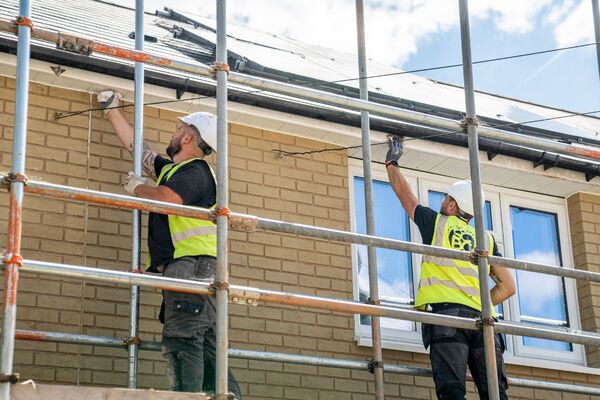You are viewing 1 of your 1 free articles
The race to reach retrofitting targets – but who gets left behind?
The race is on to retrofit millions of UK homes and bring them up to scratch to meet the government’s 2050 climate change targets. But the challenges are huge, writes Emma Mottram
Several difficult issues must be tackled if the property and construction industry is to stand a chance, including getting to grips with the skills gap, developing new technologies, and considering how all this work will be funded.
Meeting the government’s net zero target will mean the retrofitting of 27 million houses – but the money available to achieve this is currently just a drop in the ocean. It could cost around £75,000 to complete a ‘deep’ retrofit to increase energy efficiency and make a single property cheaper to run – a significant amount for social housing landlords to find.
In some cases, the energy efficiency measures may lead to fully refurbishing an entire property, especially where internal wall insulation is required. With the level of these costs and the disruption involved, landlords will no doubt consider whether it’s worth keeping their properties.
I believe the sector currently isn’t geared up to complete these works at scale – and there is nowhere near the money or skilled workforce necessary to deliver on such ambitious targets on a wholesale level.
Although the investment in retrofitting a property might pay for itself over the longer term in the reduction of bills to tenants, landlords will need to make significant capital outlays – and the link between these improvements and increased rents is not always obvious. Landlords are also facing competing pressures such as fire safety, the need for new homes, and dealing with damp and mould issues.
Pockets of money are available from the government to help but are quite targeted, such as the recently announced £75m allocated to councils and housing associations from the Social Housing Decarbonisation Fund (SHDF) for insulation, heat pumps and double glazing in up to 8,800 social homes.
“Although the investment in retrofitting a property might pay for itself over the longer term in the reduction of bills to tenants, landlords will need to make significant capital outlays”
These SHDF funding pots that local authorities and social housing providers can apply for tend to be time-limited, leading to a rush to market with everyone competing against each other for scarce resources in a ‘famine-feast’ approach.
Our sector needs to work with the industry by building up a pipeline of works based on reliable data about the housing stock and performance of measures. That will give the industry confidence to invest in product research and development and the right skills to ultimately increase capacity, reduce costs and improve the efficiency of measures over the mid to longer term.
The environmental, social and governance policy in our frameworks highlights the importance of upskilling the existing workforce, ensuring they understand how to use new technology when retrofitting.
Only around 3,000 air source heat pump engineers were trained last year – we need 27,000 to meet government targets. And there isn’t a defined pathway into some of these trades, like external wall insulation.
For our members, in the absence of reliable data about their stock and the performance of the individual energy efficiency measures, making investment decisions can be difficult. This is especially so as the development of technologies around air source heat pumps, insulation materials and batteries is still evolving. Where do they target their investments to generate the greatest efficiencies?
As a framework, we understand the importance of working through public contract regulations and ensuring a smooth and efficient procurement process for retrofitting.
The most important factor is having a long-term partnership approach, with a pipeline of commitment and understanding of the stock so that we can plan for the next two to five years and beyond. Our landlord members can help with this decision-making by capturing the data about which measures work best in which properties.
“Demand for greener technologies will continue to grow throughout the property sector… so long-term investment opportunities and tackling the skills shortage are key”
That means investment decisions are better led and the market can have confidence about delivering on a longer timescale. Demand for greener technologies will continue to grow throughout the property sector, including from private landlords and owner-occupiers, so long-term investment opportunities and tackling the skills shortage are key.
The irony is that we are still building houses that will need retrofitting in the future, when it will be even more expensive to carry out.
Some of our existing housing stock will also be too costly to retrofit – we need a more holistic approach in the master planning of our estates and regeneration programmes.
A whole market-shaping exercise needs to be carried out across the entire industry, as well as a more educational approach so that landlords, tenants, residents and contractors can understand the future benefits.
I hope that research and development work around green technology will lead the way, including new methods we haven’t yet fully grasped such as creating ‘smarter’ properties that use AI to take charge of their energy use. The finance market also has a role in developing products to incentivise and promote investment in retrofit measures and green industries.
It will be an exciting – and daunting – time as we embrace the changes needed to tackle our commitments to climate change targets, along with the skills and funding we desperately need.
Emma Mottram, director of operations, EN:Procure, the specialist procurement arm of social housing consortium Efficiency North
Sign up for our asset management newsletter
Already have an account? Click here to manage your newsletters













